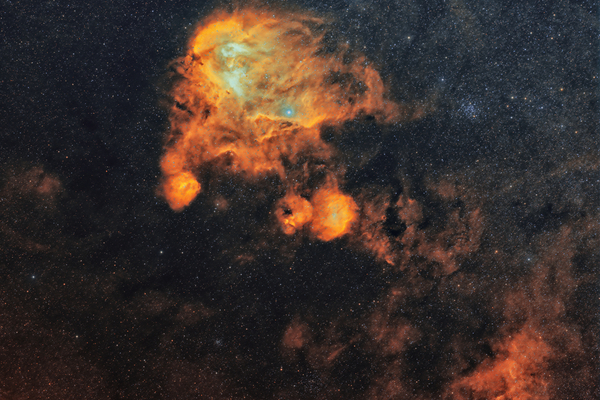The Lambda Centauri Nebula, also known as the Running Chicken Nebula, is a H II region (a region of ionized hydrogen) in the Centaurus constellation. Because of its distinctive shape, which resembles a running chicken or a Lambda () shape, it is a popular target for astronomers.
While many holiday feasts include turkey, soba noodles, latkes, or Pan de Pascua, the European Southern Observatory (ESO) is bringing you a holiday chicken this year. The Running Chicken Nebula, which is home to young stars in the making, is revealed in spectacular detail in this 1.5-billion-pixel image captured by ESO’s Paranal site in Chile’s VLT Survey Telescope (VST).
This vast stellar nursery is located approximately 6500 light-years from Earth in the constellation Centaurus (the Centaur). Young stars in this nebula emit intense radiation, causing the hydrogen gas around them to glow pink.
The observations were made with the OmegaCAM wide-field camera on the VST, a telescope owned by the National Institute for Astrophysics in Italy (INAF) and hosted by ESO at its Paranal site in Chile’s Atacama Desert that is ideal for mapping the southern sky in visible light.
The Running Chicken Nebula is actually made up of several regions, all of which can be seen in this massive image that spans an area in the sky equivalent to about 25 full Moons [Note]. The brightest region within the nebula is known as IC 2948, and some people see the chicken’s head while others see its back end. The wispy pastel contours are gas and dust plumes. IC 2944 can be found near the center of the image, marked by a bright, vertical, almost pillar-like structure. The brightest twinkle in this particular region is Lambda Centauri, a star visible to the naked eye that is much closer to us than the nebula itself.
There are, however, many young stars within IC 2948 and IC 2944, and while they are bright, they are far from cheerful. They carve up their environment by spitting out massive amounts of radiation, much like, well, a chicken. Some nebula regions, known as Bok globules, can withstand the intense bombardment of ultraviolet radiation that pervades this region. You might notice them if you zoom in on the image: small, dark, and dense pockets of dust and gas strewn about the nebula.

Other regions pictured here include, to the upper right, Gum 39 and 40, and to the lower right, Gum 41. Aside from nebulae, there are countless orange, white and blue stars, like fireworks in the sky. Overall in this image, there are more wonders than can be described — zoom in and pan across, and you’ll have a feast for the eyes.
This image is a large mosaic made up of hundreds of individual frames that have been meticulously stitched together. The individual images were taken through filters that allowed different colors of light to pass through, and then combined into the final result shown here.
The observations were made with the OmegaCAM wide-field camera on the VST, a telescope owned by the National Institute for Astrophysics in Italy (INAF) and hosted by ESO at its Paranal site in Chile’s Atacama Desert that is ideal for mapping the southern sky in visible light. This mosaic was created using data from the VST Photometric H Survey of the Southern Galactic Plane and Bulge (VPHAS+), a project aimed at better understanding the life cycle of stars.
Notes
[Note] This image, edge to edge, is 270 light-years wide. It would take an average chicken almost 21 billion years to run across it. That’s much longer than our Universe has been around for.




